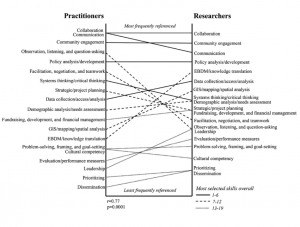How do we develop liveable cities? Researchers in St. Louis surveyed multiple disciplines to see what skills we need to make future places healthy, equitable, and enjoyable for all.
For the attention of: Public health associations and the professional bodies for planners, landscape architects, architects and their members. National recreation and park associations and research communities for active living.
The problem: One of the most popular and intuitive ways to capture quality of life in cities is by evaluating “liveability.” Though exact definitions vary, many metrics treat active living as a core consideration for liveability.
Despite growing awareness about the importance of liveability and active living, there has been to our knowledge no attempt to identify the competencies necessary to participate in the development of liveable cities.
What we did: Participants were asked to provide a list of the skills they found most important to the development of liveable cities. Responses were synthesized into broader categories, and respondents were then asked to select up to five categories that they felt were most important. Results were compared to the competency requirements for program accreditation in the fields of Public Health, Urban Planning, Architecture, Landscape Architecture, and Parks and Recreation Administration. This chart compares practitioners and researchers based on the frequency of their references to each skill. On the left, skills are ranked from top to bottom by frequency of references by practitioners. On the right, they are ranked by frequency of references by researchers. A line connects each skill’s placement on both sides, illustrating any relative gaps. Gaps are relative, not absolute. A higher placement on one side indicates more references than lower skills on the same side, not the opposite side. The pattern of each line reflects the overall frequency of reference for each skill.
This chart compares practitioners and researchers based on the frequency of their references to each skill. On the left, skills are ranked from top to bottom by frequency of references by practitioners. On the right, they are ranked by frequency of references by researchers. A line connects each skill’s placement on both sides, illustrating any relative gaps. Gaps are relative, not absolute. A higher placement on one side indicates more references than lower skills on the same side, not the opposite side. The pattern of each line reflects the overall frequency of reference for each skill.
What our study adds: We provide a first look at what skills are most important for liveable city development plus;
- a transdisciplinary perspective on how these skills are currently being taught and can be taught,
- new insights on how these translate to workforce development and team-building.
Implications for city policy and practice: It is vital to:
- Keep teaching “soft skills” like communication, collaboration, and community engagement and find more effective new ways to teach them.
- Use workforce development to close gaps between researchers and practitioners and boost currently under-taught skills.
Always consider team processes and composition when forming teams. This means knowing what skills each discipline brings to the table.
More information about our work at: The Developing Livable Cities initiative at the Prevention Research Center in St. Louis.
Twitter feeds:
Trailnet To lead in fostering healthy, active and vibrant communities where walking, bicycling and the use of public transit are a way of life.
Sam Fox School The Sam Fox School of Design & Visual Arts is an interdisciplinary school of architects, artists, & designers at Washington University
PRC in St. Louis The Prevention Research Center in St. Louis: Adapting, implementing, evaluating, and disseminating evidence-based interventions to prevent chronic disease.
Full research article: Developing livable cities: Do we have what it takes?
Authors: Samuel Yang, Amy Eyler, Ross Brownson, Linda Samuels, Grace Kyung, Rodrigo Reis
Editor: Marcus Grant




